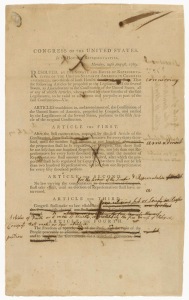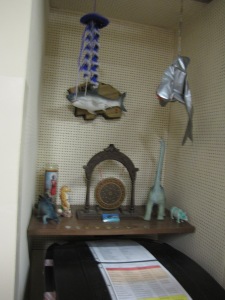At some point in the not-too-distant past, the staff at the National Archives became aware that Congress, the entity who provides the money to fund the Archives, had absolutely no idea what the Archives did. Thus began a program to educate the Members of Congress and their staffs. I was fortunate recently to go to a staff tour as the guest of a fellow Fellow who has been on several tours I’ve arranged, thus demonstrating that one good turn deserves another.
The National Archives was created by law in 1934 as the official record keepers of the government. They hold records for both the legislative and executive branches, including committees. They have long enjoyed a rivalry with their older sibling, the Library of Congress, which developed more of a copyright function rather than archives. The Library of Congress no longer accepts the personal papers of Members of Congress with only a few exceptions, the most recent being Senator Daniel Patrick Moynihan and Congresswoman Nancy Pelosi. The Archives holds both paper and electronic records. There are half a billion paper items and electronic records currently occupy about 77 terrabytes of space. As an illustration, there were 20 million emails archived from the Clinton White House years. From the George W. Bush years, that number grew to 200 million.
We started our tour before the tourists were allowed to enter the building, so we got a little time to view the Declaration of Independence, the Constitution, and the Bill of Rights without a crowd. The Declaration is faded so much that it is all but unreadable, and we learned that it was a result of 70 years of being hung in a window in the State Department before being transferred to the Library of Congress and eventually to the Archives. The Constitution, which was stored at Fort Knox, fared much better. We were told that other than fire, light is the worst enemy of old documents. Even papers that have been through a flood may be freeze-dried and salvaged more easily than those damaged by light.
As it came time for the Archives to open to the public, we were taken to an upper floor to the Legislative Archives Vault. We all sat around a table, and our two hosts took turns showing us documents and telling us stories. Each document was contained in a plastic sleeve that was then stored in a sturdy folder. We were not allowed to touch anything, but the proximity was still inspiring.
We started with the document signed by George Washington nominating the first Supreme Court justices as well as a number of other justices. All of the nominees were confirmed except for one, who was the subject of a long term grudge by one of the senators. Washington himself came to the Senate to find out what the problem was, and the senator who had the issue announced something like, “I’ll be damned if I’ll let him be confirmed.” Thus began the tradition of senatorial courtesy whereby the President runs the nominees by the Senate before it is all made official.
Next we saw the legislative mark-up of the Bill of Rights. A formal typewritten copy of the language that was passed by the House was sent forward to the Senate, and that document shows the inked changes made when the bill passed the upper chamber, often involving the deletion or rearrangement of amendments. For example, there was one amendment that stated that there would be one House member for every 50,000 residents. If that had not been deleted, the House of Representatives would currently have over 6,000 members. It was fascinating to see how the final document was shaped through the process of moving through Congress.

Bill of Rights Mark-up
We next saw the 1804 Presidential proclamation to Congress in Thomas Jefferson’s own hand of the Louisiana Purchase. Someone apparently challenged Jefferson’s authority to purchase that much land in his role as President and said that it was unconstitutional. Jefferson calmly replied that no, it was extra-constitutional, or outside of the Constitution. As a related document, we saw a petition from Daniel Boone who held land in Missouri as a grant from the Spanish crown. With the Louisiana Purchase, Boone lost title to his land, so he petitioned to have it restored. Boone was apparently one of many people who were hedging their bets by playing both sides of the land sovereignty issue, but Boone was indeed allowed to keep his land.
As you may recall, in 1814, the British arrived in Washington and burned both the White House and the Capitol. Dolly Madison gets great credit for saving so many of the records from the White House as well as the portrait of George Washington. Over on Capitol Hill, the Senate got a bit of a jump on the situation, gathered some wagons, and they were able to move many of their documents out of the Capitol before the British arrived. The House waited a little too long, were unable to find many wagons, and thus they lost more records in the fire.
Because I was with a group of committee staff, we were shown the 1816 resolution creating a set of standing committees for the Senate. The government had been functioning for long enough that it was becoming clear what committees were important for ongoing business. In addition to the Committee on Public Lands, now the Committee on Energy and Natural Resources, there were also committees on Military Affairs and on Post Roads. A Committee on Ways and Means was also created in this resolution, but it was quickly renamed the Finance Committee to distinguish it from the House committee.
A larger box contained a giant rolled petition that was about 12” in diameter. It was kept rolled with a ribbon that had long-since faded to pink, but it was the original governmental red tape; one had to cut through it to get to the actual information.
On stationery from the Executive Mansion (it wasn’t called the White House until much later), we saw the note from President Lincoln appointing Ulysses S. Grant to be Lieutenant General of the Union Army. Apparently this was a somewhat controversial appointment since Grant was considered to be a bit of a drunk. When this complaint was aired to President Lincoln, he suggested, “Buy a case of whatever Grant drinks and give it to the rest of my generals!”
The impeachment resolution of President Andrew Johnson for “high crimes and misdemeanors,” (also known as, “we’ll figure out what to charge you with later”) was hand-written on a half sheet of paper. The Congressman who offered the resolution apparently kept the paper in his pocket for some time just waiting for the President to provide an opportunity for the resolution’s use.

Impeachment resolution for Andrew Johnson
Two documents about women’s suffrage offered an interesting contrast. The first was from the National Women’s Suffrage Association and was signed by Susan B. Anthony and Elizabeth Cady Stanton, advocating giving women the vote. A second document, also signed entirely by women, was from the National Association Opposed to Women’s Suffrage. Among their other objections to the concept was that this path forward would serve as “an official endorsement of nagging as a national policy.”
D-Day was a theme that linked two completely different documents. The first document was a de-classified map made as Americans were just starting to experiment with the newly developed radar technology. Two young servicemen on one of the Hawaiian Islands turned on their machine around 7 AM on December 7th, 1941. They got a huge blip on their map, so they turned off the machine, recalibrated it, and turned it back on. The blip remained. They called the base on Oahu, although it took a while to get anyone on the phone. They were assured that their blip was the American bombers out of San Francisco who were expected to arrive any day, and they were told that they didn’t need to continue the radar tracking. The two chose to use the blip as a training exercise, and they tracked what turned out to be the Japanese planes until they were lost in the mountains of Oahu en route to the bombing of Pearl Harbor.
The next document was the speech that President Roosevelt gave to Congress the following day announcing the “Day that will live in infamy,” and requesting that Congress declare war on Japan. As an interesting piece of trivia, John Dingell was on the floor that day as a page for his father, who was a Member of Congress. We were reminded that this was the last time that Congress has declared war; all other military engagements have lacked this important part of the process.

“A day that will live in infamy”
The radar map brought up interesting questions of handling information that is sealed for a specified period of time as well as information that is classified. The computer systems at the Archives have no network access, and electronic documents are transferred via hard drive and sneaker-net rather than electronically. Archivists are challenged by hardware compatibility and the sheer volume of information. They also are always concerned about how to store electronic records safely and securely. As the staff say wistfully, “We’ll always have paper.” I shared their sense of wonder to see a piece of paper handled by Washington or written by Jefferson. It was a wonderful experience, and I would certainly be happy to support their budget.


























